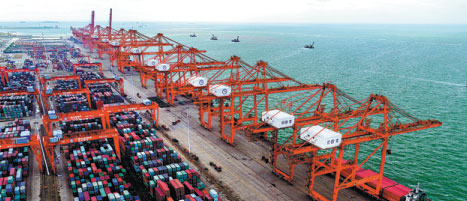Guangxi's land-sea channel further opening up country's western areas to the rest of the world
Heading southeast from Bangkok, it takes about four hours by car to reach Chanthaburi province, known as Thailand's "land of fruit", that teems with tropical fruit like durian and mangosteen.
In recent years, thanks to rapidly increasing sales of Thai durian in the Chinese market, many local fruit merchants have made a tidy profit.
Statistics estimate that the trade volume of fresh durian from Thailand to China will hit a new high in 2021, with China remaining the top durian export market for Thailand for the foreseeable future.
In Oudomxay province in Laos, Chinese enterprises have invested in the construction of modern banana plantations, which has employed locals and improved their living standards.
Cooperation between China and the 10-member Association of Southeast Asian Nations, better known as ASEAN, in the fruit industry is only part of thousands of win-win exchanges in China-ASEAN economic and trade cooperation.
To further enhance China-ASEAN economic and trade cooperation is in line with the high-quality development of diplomatic relations, and also a top priority for accelerating the full recovery of the regional economy in the face of the COVID-19 pandemic, according to Yang Chunting, director of the Department of Commerce of the Guangxi Zhuang autonomous region.
The China-ASEAN Expo, as a practical platform to promote regional economic integration, is duty bound to play a bigger role in promoting the all-around development of economic and trade cooperation between China and ASEAN, and even East Asia, according to the organizers of the upcoming 18th CAEXPO, running from Sept 10-13 in Nanning, capital of Guangxi.
Statistics show that since the establishment of China-ASEAN relations 30 years ago, trade between the two sides has expanded 85 times. In 2020, China-ASEAN trade reached $684.6 billion, making ASEAN China's largest trading partner.
By the end of June, investment between China and ASEAN members exceeded $310 billion, in sectors including high-tech, digital economy, green economy and traditional industries.
In November 2020, China together with the ASEAN and four other countries including Japan and Australia, signed the Regional Comprehensive Economic Partnership, marking the establishment of the world's largest free trade deal and area.
The CAEXPO additionally is helping drive the upgrading and development of the free trade area, according to the expo organizers.
Over the past 17 years, the expo has highlighted business opportunities between China and ASEAN in trade, investment cooperation, advanced technology and urban cooperation.
In terms of investment promotion, the expo has held a series of promotion events and conferences to publicize advantages and policies, share business opportunities and experiences, and answer questions about where to invest, what to invest in and how to invest.
A total of 86 international and domestic investment and cooperation projects were signed at the 17th CAEXPO in 2020, the total investment of which increased by 67.8 percent compared with the previous expo.
With the theme of jointly building a new land-sea trade channel for a stronger China-ASEAN community with a shared future, the 18th CAEXPO will be held both online and offline, paying close attention to such areas as the RCEP, investment promotion and new markets.
Guangxi, as host of the CAEXPO, is speeding up the construction of a new land-sea channel in the western part of China, to open wider to the outside world and strengthen coordinated development with other parties along the route.
By the way of Guangxi, Guizhou province and Gansu province, the new land-sea channel utilizes rail, sea and road transportation to support western China's participation in international economic cooperation.
The development of the new land-sea channel in the west has provided a new pivot and hope for China-ASEAN economic cooperation and post-epidemic economic recovery, according to Guangxi officials.
In recent years, Guangxi has been committed to accelerating the development of its Beibu Gulf Port and China-Europe freight trains, helping to connect western China with the rest of the world, said a senior official of Guangxi's Development and Reform Commission.
The Beibu Gulf Port has opened 54 container lines, 30 of which are for foreign trade, covering seven ASEAN member countries-Malaysia, Thailand, Singapore, Vietnam, Cambodia, the Philippines and Indonesia-according to officials with the Guangxi Office on Planning, Development and Management of the Beibu Gulf Economic Zone.
From January to July, the cargo handling capacity of the port reached 204 million metric tons, up 21.8 percent year-on-year.
The autonomous region has launched China-Europe freight trains from its cities of Liuzhou and Nanning headed to Russia and Kazakhstan.
Data show that in the first seven months in 2021, the trade volume of 14 provinces, autonomous regions and municipalities along the new land-sea channel in the west with ASEAN member countries reached $71.42 billion, up 30.5 percent year-on-year.

Detian-Ban Gioc Falls in Chongzuo, Guangxi Zhuang autonomous region, straddles the border between China and Vietnam and is Asia's largest cross-border waterfall. DENG HUA/FOR CHINA DAILY

Qinzhou Port is part of the Beibu Gulf Port in the Guangxi Zhuang autonomous region. CHINA DAILY

The first China-ASEAN Expo is held in 2004 in Nanning, capital of the Guangxi Zhuang autonomous region. CHINA DAILY